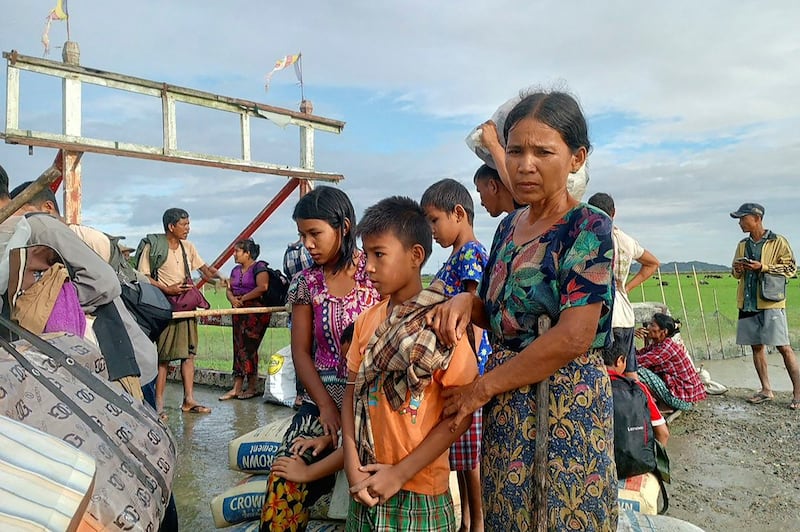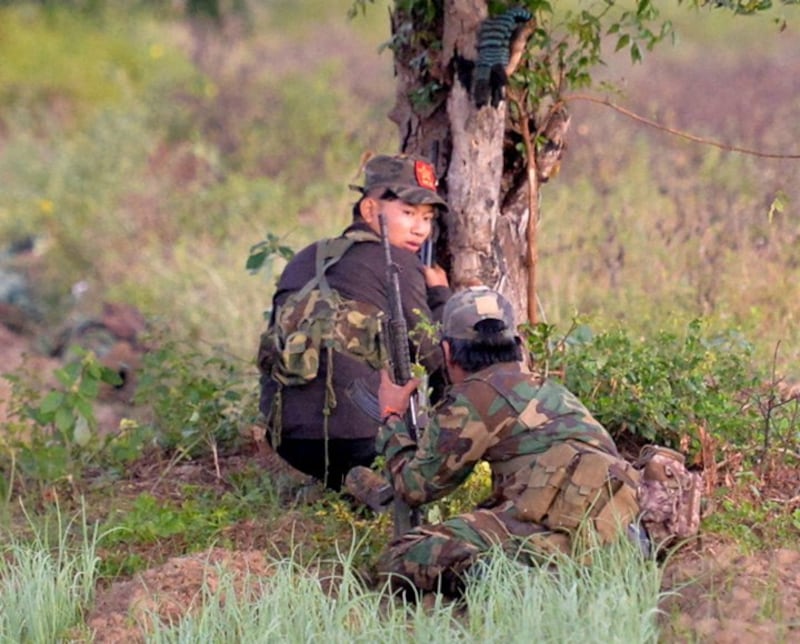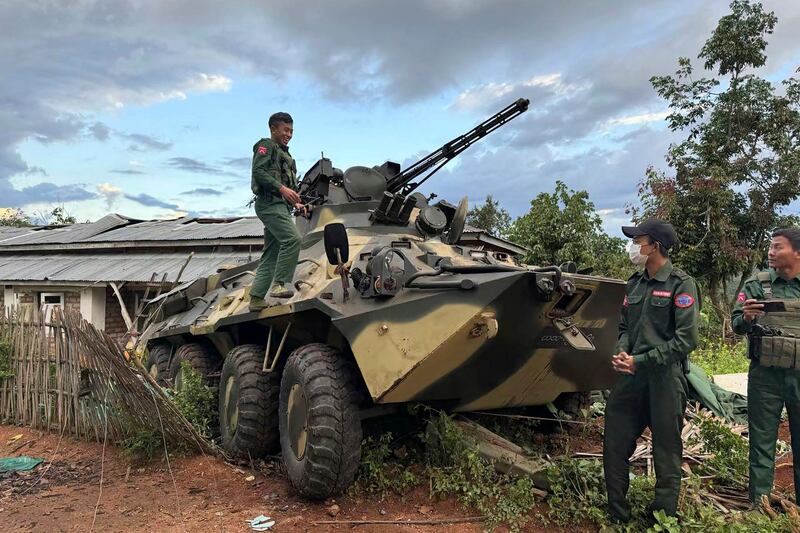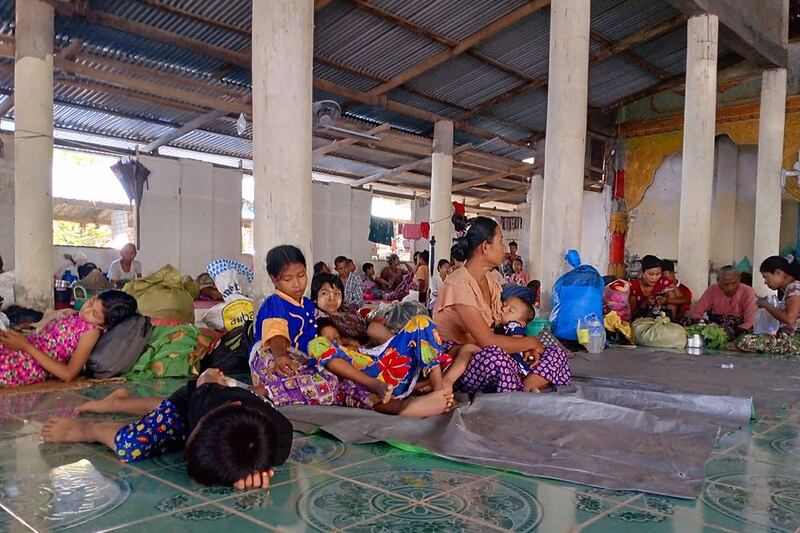One month into renewed hostilities between the military and ethnic rebels in western Myanmar’s Rakhine and neighboring Chin state, the Arakan Army claims to have seized dozens of junta camps, including major bases along the borders with India and Bangladesh.
The advance is the latest success in what experts are saying appears to be a turning point in the country’s nearly three-year civil war, with rebel armies taking control of several key cities in northern Shan state and junta soldiers surrendering.
Since the Arakan Army and two other ethnic rebel armies launched Operation 1027 – named after the Oct. 27 military actions that started it – as part of the "Three Brotherhood Alliance," junta troops have been on the retreat in many areas, leading junta chief Senior Gen. Min Aung Hlaing in late November to issue a rare acknowledgement of the rebel's successes.
Nearly 400 junta soldiers – including two full battalions – and 56 junta police officers surrendered in battles across Myanmar in November alone, while around 100 other members of the junta's forces were arrested last month, according to the country's shadow National Unity Government, or NUG, made up of former civilian leaders and anti-junta activists.

The victories are piling up. Just this week, the Arakan Army, or AA, said it had seized more than 40 military sites, including Ta Ron Aing and Hnone Bu bases, located in Chin’s Paletwa township around 16 kilometers (10 miles) from India’s Mizoram state, and Done Nyo and Kha Htee Hla bases, in Rakhine’s Maungdaw township along the border with Bangladesh.
The advances come a month after the AA attacked guard police outposts and junta convoys in Rakhine's Rathedaung and Minbya townships, ending a ceasefire brokered one year ago on humanitarian grounds.
The AA claimed to have also seized Done Paik and Chein Khar Li – two border guard bases on Myanmar’s main trade route with Bangladesh.
Key bases
A resident of Rakhine who, like others RFA interviewed for this report, spoke on condition of anonymity due to security concerns, explained the importance of the bases to the junta.
“Ta Ron Aing and Hnone Bu … are the gates of Myanmar and Rakhine to India,” he said, adding that the two bases are also located near the main site of the Kaladan Road Project – a US$484 million bid to connect eastern India’s port of Kolkata with the port of Sittwe in Rakhine.
“These bases are geographically very important, and seizing the outposts of Done Paik and Chein Khar Li means that the Maungdaw-Sittwe highway is now controlled [by the AA].”
The two ethnic offensives – and a third launched by the Karenni Army, Karenni National Defense Force, and anti-junta People’s Defense Force, or PDF, paramilitaries on Nov. 11 – are part of a much wider conflict that have seen ethnic armed organizations and the PDF capture 22 townships and military outposts in the past two months in Shan, Chin, Kayah, and Rakhine states, as well as Sagaing and Bago regions.
Political commentator Than Soe Naing told RFA he believes battles for control of Myanmar’s townships will lead to a political turning point in coming months.
“Under attack in multiple regions, the junta has a shortage of forces and its soldiers have poor morale,” he said. “They don’t have the confidence to protect [the capital] Naypyitaw, so many of them simply surrender after battles. I expect significant changes will occur in the coming months.”
Armed clashes are escalating across the country. A Dec. 8 report by the Institute for Strategy and Policy-Myanmar, an independent research group, found that armed conflict is taking place in just over two-thirds of Myanmar’s territory. At least 261 of Myanmar’s 330 townships have been caught up in fighting since the military’s Feb. 1, 2021, coup d’etat that triggered the civil war.
Predicted outcomes
Observers told RFA that as the country’s armed conflict has widened, the junta has increasingly ceded power.
“The resistance forces have captured territories, outposts and towns, while the junta can’t even prepare for a defensive war,” said Pe Than, a veteran ethnic Rakhine politician and former lawmaker. “Junta soldiers have surrendered and the military is gradually collapsing.”
Pe Than said he also sees the possibility that other military officers will sideline junta chief Min Aung Hlaing.
But others warned of possible setbacks to the armed resistance.

Political commentator Sai Kyi Zin Soe said that, provided they establish good ties and mutual trust, he believes the ongoing conflict will end in the anti-junta forces’ favor.
“If they could maintain these things, there will be more advantages in negotiation as the resistance forces have demonstrated military superiority,” he said.
If they do not, “it will lead to a split within the armed resistance.”
Military experts told RFA that the longer the conflict lasts, the higher the risk that anti-junta forces will run out of the funding necessary to acquire arms and ammunition.
“It’s not easy to supply a conflict,” said Aung Myo, a former military officer. “Even a national-level organization [like the NUG] can face difficulties obtaining such supplies, and we predict that the anti-junta forces cannot afford a long war.”

China-based political commentator Hla Kyaw Zaw said that, as an institution firmly entrenched in nearly all aspects of life in Myanmar, the military will not go quietly.
But he said he believes that the regime “will surely fall,” and that it is simply a matter of how soon.
“Its immediate or gradual collapse will depend on both the resistance forces and the people, and their endurance,” he said. “But the military has toned down its rhetoric and their position has weakened.”
Growing displacement
Meanwhile, the number of internally displaced persons, or IDPs, in Myanmar is increasing by the hundreds of thousands as the country’s armed clashes intensify.
Among the IDPs, Lom Mi and her family have been taking shelter at a Christian orphanage in Shan state’s Lashio township since Nov. 7, when the military shelled their village of Namhu along the Lashio-Hsenwi highway.
She said that she and her relatives fled because they fear an escalation in fighting, and what it might mean for the young and elderly in their village.
Lom Mi said she hopes that no one else will have to experience the clashes that came to Namhu, but she knows that many IDPs are experiencing similar hardships.
“Ordinary people have suffered many losses in both their farming and livestock businesses [due to the fighting],” she said. “In some villages, the locals could not harvest their crops or take their animals as they fled their homes … I hope this situation will end in one or two months, but I cannot imagine what will happen next.”

Since the start of fighting between the military and the AA in Rakhine state last month, thousands have fled their homes. But they represent the tip of the iceberg in Myanmar’s long-running conflict.
Last week, the United Nations Office for the Coordination of Humanitarian Affairs, or UNOCHA, reported that some 578,000 civilians had fled their homes since the start of Operation 1027 alone, bringing the total number of displaced since the coup to 1.9 million people, or nearly one out of every 30 people in Myanmar.
Mya Than Win, a 53-year-old woman from Nyaung Chaung village, in Rakhine’s Buthidaung township, is one of those who have left their homes to escape the fighting raging throughout the country.
“[The junta has] made our lives difficult and now we live in very poor conditions because of the many problems they have caused,” she said. “I feel terrible for the sacrifices so many Rakhine people have made. We want them to leave.”
Translated by Htin Aung Kyaw and Aung Naing. Edited by Joshua Lipes and Malcolm Foster.
